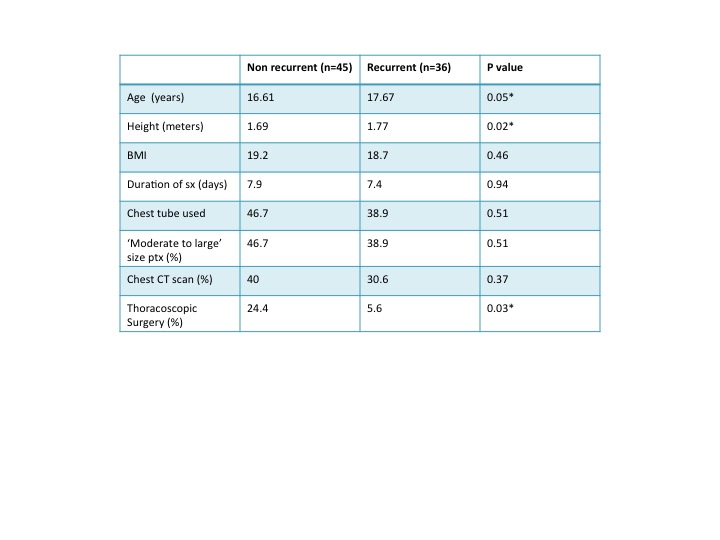L. M. Soler1, D. W. Kays1, S. D. Larson1, J. A. Taylor1, S. Islam1 1University Of Florida,Pediatric Surgery,Gainesville, FL, USA
Introduction: The management of primary spontaneous pneumothorax (PSP) in children is controversial, with some studies suggesting a recurrence rate of 50% over a 4 year period and advocating no surgery for the first occurrence. The purpose of this study was to understand the optimal management of a first episode of spontaneous pneumothorax.
Methods: A retrospective cohort at a single center over 12 years (2002-2014) was studied. Cases of PSP in the 5-19 year age group were selected and other pneumothoraces excluded. Data regarding pre, hospital, and post hospital course was collected and analyzed, with recurrent PSP the primary outcome variable.
Results: 362 cases of pneumothorax in children were found, and 81 met the inclusion criteria for PSP. An overall recurrence rate of 44.4% was noted, with 89% within 12 months of the initial PSP. Recurrent PSP cases were older and taller, but were similar to the non recurrent ones in use of chest tubes, and in the proportion of initial CXR being moderate or larger pneumothorax. CT scan use was not significantly different between recurrent and non recurrent groups, and 5/6 CT scans read as ‘normal’ had recurrence. Thoracoscopic surgery resulted in a significantly lower rate of recurrent PSP (Table). Patients who did not undergo surgery had a 50% recurrence rate with 90% within 12 months of the initial PSP.
Conclusion: Recurrence after PSP in children and adolescents was high and a majority occurred within a year requiring readmission. A negative CT scan for subpleural blebs still had a high recurrence, while thoracoscopic blebectomy and pleurodeisis had significantly lower recurrence. These data may suggest a more aggressive surgical approach to initial PSP in children.
